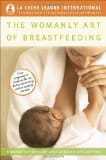
When I opened my new copy of the Womanly Art of Breastfeeding (WAB), I wondered whether LLL made the correct decision by retaining the original title. The current edition, by leading lactation experts Diane Weissinger, Diana West and Teresa Pitman (all of whom I know and respect), is a complete rewrite. Previous revisions of the WAB, first published in 1958, added and updating but kept the core intact.
Readers of the Womanly Art have criticized it for “pushing” strong views of parenting on its readers. Comments on a guest post where I recommended the WAB reflected this. But even the naysayers acknowledged that WAB has always had the most comprehensive and up-to-date technical breastfeeding information available. Neither has changed in the new edition. Those readers who disagree with LLL’s approach to mothering through breastfeeding might still object, but they will buy the book anyway because of the vast amount of information.
One controversial section in the new edition include a recommendation not to use hormonal birth control until six months In previous editions the progestin-only pill is considered to have minimal effect on supply.
As an expectant mom, The Womanly Art gave me a perspective on mothering I wouldn’t have considered otherwise. I had little support and needed much more than technical information. The new edition doesn’t dilute the classic LLL approach to keeping your baby close, following baby’s lead, staying home with your baby or arranging a working schedule to allow maximum togetherness, discipline, toddler nursing, and weaning. But instead of a chapter on each topic, the essence is mentioned in a few pages along with book recommendations. Throughout, it encourages mothers to overcome challenges. The authors see the goal as a loving relationship with the baby.
The authors devote a long section to birth, explaining that few books go into detail on the effect of interventions, including epidurals, on breastfeeding. Other chapters discuss nesting, building a network, “latching and attaching,” common concerns at different stages of breastfeeding, solids, weaning, sleeping and working. Two fact-filled chapters address special concerns like prematurity, adoptive nursing, multiples, and common problems. You’ll find sections on piercing, breast surgery, d-mer (a condition where mothers have a short, sudden emotional dip during a milk ejection reflex), tongue-tie including pictures of lesser-known types, depression, and much more, along with resources for further information on each topic.
At the end of the book you’ll find LLL resources, “tear-off sheets” with charts and useful information for family and friends, and scientific references.
Previous editions referred to the mother as “she” and the baby as “he.” The new edition addresses the mother as “you,” and alternates the gender of the baby. This is a clever approach, although the perky style with an excess of exclamation points— “How important is breastfeeding, really? Extemely!”—may make some mother feel talked down to. And while the content is universal, I wonder whether the style will appeal to readers outside the US.
Expectant and new moms not looking for mothering advice will buy this book for the information, and be sure to find the answers they need. But putting the needs of the baby first, without neglecting your own, has helped mothers throughout history succeed at breastfeeding and learn to enjoy motherhood. Skeptical readers may be surprised to find how much of LLL’s approach in the newest edition of Womanly Art of Breastfeeding (WAB) still works in today’s world.
You may also enjoy:
An Alternative to Adler: Parenting Answers from Dr. Gordon Neufeld
Breastfeeding in Public: The “Cringe” Factor
Hannah, I just wanted to say that I love your review. It is so thorough! It took me way too long to read my copy and I felt bad with how late my official review was, although I was inspired to write about topics that came up a couple times while reading it. I think if I had read straight through I would have been able to retain more info for my own review and done something a little more like yours – just more detailed. Anyway, kudos. This is excellent. I hope some of my readers will hop over to your review as well. I am glad you linked to it in your comment.
Funny you should say that–I was one of the first to read the book in July when it came off the press. Visiting the US I developed a foot infection, and I had to stay off my feet for nearly a week! So I was able to read through the book quickly and write about it. Thanks,Melodie, of course you’re welcome to link directly to the review.